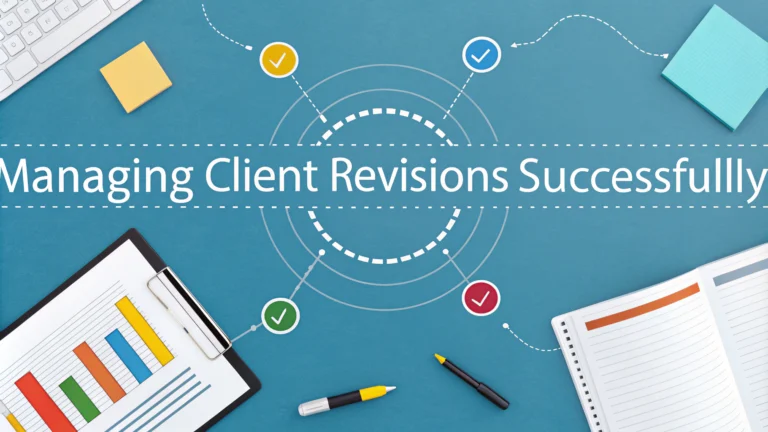Managing client revisions for logo design projects requires a structured approach and clear communication from the start.
Setting clear expectations about the revision process in your initial contract helps prevent misunderstandings and scope creep.
Establishing a Revision Framework
- Define the number of included revisions (typically 2-3 rounds)
- Set clear pricing for additional revision rounds
- Outline turnaround times for each revision
- Specify how feedback should be submitted
Creating an Effective Feedback System
Use a structured feedback form or template to gather specific client input on design elements.
| Design Element | What to Ask |
|---|---|
| Colors | Which specific colors need adjustment? |
| Typography | What aspects of the font aren’t working? |
| Layout | Which elements need repositioning? |
Tips for Smooth Revision Management
- Document everything – Keep written records of all revision requests
- Version control – Name files systematically (e.g., ClientName_Logo_V1.2)
- Present options – Show 2-3 variations addressing each major revision point
- Set deadlines – Give clients specific timeframes for feedback
Red Flags to Watch For
Be cautious when clients start making frequent, small changes without clear direction.
Consider implementing a ‘revision freeze’ after a certain number of rounds to maintain project momentum.
Tools for Revision Management
- InVision – For interactive feedback
- Filestage – For organized review cycles
- Dropbox Paper – For collaborative feedback
Sample Revision Clause for Contracts
“This project includes two (2) rounds of revisions. Additional revision rounds will be billed at $XX per hour with a minimum of one hour per round. Each revision round must be submitted as a single consolidated feedback document within 5 business days of receiving the design.”
When to Say No to Revisions
- Changes that compromise brand effectiveness
- Requests outside the project scope
- Revisions that violate design principles
Maintain professional boundaries by explaining your decisions with solid design reasoning rather than personal preference.
Next Steps
Create a revision management template that works for your specific workflow and client base.
Consider offering a post-project brand guide to reduce future revision requests.
Implementing Revision Tracking
A systematic approach to tracking revisions helps maintain project organization and ensures nothing falls through the cracks.
Revision Tracking Elements
- Date of revision request
- Specific changes requested
- Client feedback documentation
- Implementation timeline
- Status updates
Client Communication Strategies
Clear communication channels and expectations help streamline the revision process and maintain professional relationships.
- Schedule regular check-ins
- Provide progress updates
- Document all decisions
- Use visual references
Managing Difficult Situations
Sometimes revision requests can become challenging. Having strategies in place helps maintain professionalism.
Common Scenarios
| Situation | Solution |
|---|---|
| Endless revisions | Reference contract limits and suggest new project scope |
| Vague feedback | Provide structured feedback forms |
| Scope creep | Clearly outline additional costs |
Conclusion
Successful revision management relies on clear processes, effective communication, and strong boundaries. By implementing these strategies and maintaining professional standards, designers can deliver successful logo projects while preserving client relationships and project profitability.
Remember that a well-structured revision process not only improves current projects but also sets the foundation for future client relationships and referrals.
- Review and update your revision policy regularly
- Gather feedback from completed projects
- Refine your process based on experience
- Stay consistent with your established guidelines
FAQs
- How many rounds of revisions should I include in my logo design contract?
Most professional logo designers include 2-3 rounds of revisions in their standard package, with additional rounds available at extra cost to prevent endless modifications. - What’s the best way to collect client feedback for logo revisions?
Use a structured feedback form that asks specific questions about colors, shapes, typography, and overall impression, and request consolidated feedback rather than piece-meal changes. - How do I handle clients who keep requesting minor tweaks beyond the agreed revision rounds?
Clearly communicate when they’ve reached the limit of included revisions and provide a per-revision rate for additional changes, referring back to the original contract terms. - Should I charge for additional revision rounds?
Yes, additional revision rounds beyond the contracted amount should be charged at a predetermined rate to value your time and maintain project profitability. - How can I prevent revision cycles from dragging on indefinitely?
Set clear deadlines for feedback, implement a revision cap in your contract, and require written approval for each version before proceeding with changes. - What information should I request from clients during the revision process?
Ask for specific feedback about what’s not working, their desired outcome, reference examples if applicable, and ensure all stakeholders provide input simultaneously. - How do I maintain version control during the revision process?
Use a clear naming convention for files, maintain a revision log, and present only one version at a time to avoid confusion and track changes effectively. - What’s the best format to present logo revisions to clients?
Present logos in both color and black/white versions, show them in context (mockups), and provide a brief explanation of the changes made based on their feedback. - How do I handle conflicting revision requests from different stakeholders?
Request that clients designate a single point of contact who will collect and consolidate all stakeholder feedback before submitting revision requests. - When should I stand firm on my design decisions during revisions?
Stand firm when requested changes compromise brand effectiveness, violate design principles, or could harm the client’s business objectives, but always explain your reasoning professionally.








